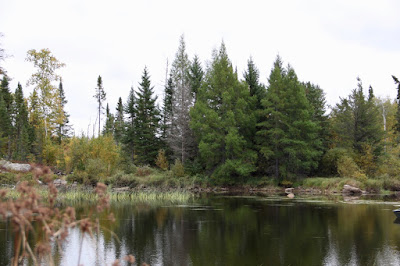But National Secretary of the Australian Workers Union, Daniel Walton said that many of the workers on the site still don't feel safe given the recent earthquakes.
"A lot of workers are worried that the mine is not taking this activity seriously enough and they do have concerns about safety," he said....
In a statement, Newcrest said that safety was its highest priority as it worked to assess the impact of the wall break.
“The Cadia tailings dams have been regularly inspected, reviewed and monitored; and have been fully certified to industry standards by independent third parties.
 |
| how valuable is this land and the waters that flow through it?
Photo by J. Harrington
|
Those statements read a lot like the mining jobs versus the environmental protection perspectives regarding the proposed PolyMet NorthMet project. Perhaps we've missed it but we don't recall any discussion about what potential for failure is acceptable. A place to start might be the Precautionary Principle.
When evidence gives us good reason to believe that an activity, technology, or substance may be harmful, we should act to prevent harm. If we always wait for scientific certainty, people may suffer and die and the natural world may suffer irreversible damage.
Q. How do we implement the precautionary principle?
A. The precautionary principle is most powerful when it serves as a guide to making wiser decisions in the face of uncertainty. Any action that contributes to preventing harm to humans and the environment, learning more about the consequences of actions, and acting appropriately is precautionary.
An alternative perspective might be to clarify the Degree of Risk we're willing to accept, along with the corresponding damage, to the likelihood of eventual failure. There has been some well regarded work on risk management frameworks in regard to climate change security. Perhaps that framework could be adapted for use with tailings dams.
Precaution does not work if it is only a last resort and results only in bans or moratoriums. It is best linked to these implementation methods:
- exploring alternatives to possibly harmful actions, especially “clean” technologies that eliminate waste and toxic substances;
- placing the burden of proof on proponents of an activity rather than on victims or potential victims of the activity;
- setting and working toward goals that protect health and the environment; and
- bringing democracy and transparency to decisions affecting health and the environment.
The report proposes a Three-Tier “ABC” Framework for developing a risk management strategy and makes 10 recommendations for priority actions governments should take to begin implementing the framework.Some of us remember the tragedy of the Challenger explosion and the subsequent report. Richard Feynman was a member of the Commission that prepared the report.
Feynman's own investigation reveals a disconnect between NASA's engineers and executives that was far more striking than he expected. His interviews of NASA's high-ranking managers revealed startling misunderstandings of elementary concepts. One such concept was the determination of a safety factor.[6]What should be the safety factor for any given tailings dam, and how will we know when it's been provided? Is the size of the safety factor satisfactory in light of the value of the resources at risk? Has anyone found answers to those questions? Have they already been, as lawyers sometimes say, "asked and answered?" This article in the Pioneer Press would seem to indicate that they haven't.
Sorehead
By John Tranter
I was arrested because of that internal memo,and ended up in a cell, then I was told to sitwith the police and the local bigwigs.In the hushed and fast darkening room they saidsomeone—someone—had reduced the safety marginon the airport risk factor, and I got the blame.The sky that day was a pale, clear blue, butthat was happening outside, and far away.The cop on duty would not open the tombof the deported—sorry, departed—and as usualhe had a story. Every movie, he said, dependson a script, and the narrative grows out ofmarket research: a set of standard deviations. Art?What would they know? Open the tomb, and let me in.
********************************************
Thanks for visiting. Come again when you can.
Please be kind to each other while you can.
No comments:
Post a Comment